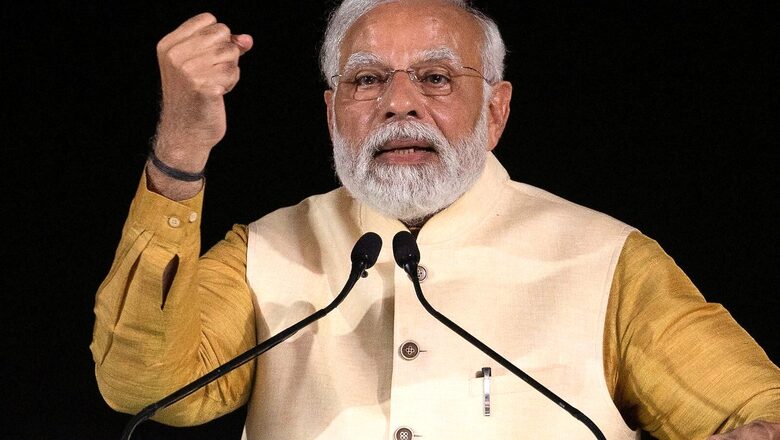
views
Union Budget 2023-24, the last full budget before general elections in 2024, has to be one of the best presented in the last many decades due to significant emphasis on green growth, capital expenditure (CapEx), rural support, inclusivity, tourism, the welfare of tribals and farmers, skilling of youth, empowerment of artisans, infusion of Rs 9000 crore into the credit guarantee corpus for MSMEs, reversal of inverted duty structure, 33 percent hike in PM Awas allocation to Rs 79,000 crore, proposal to set up ten Bio-Input Resource Centres, the decision to set up 157 nursing colleges in co-location with the existing 157 medical colleges and above all—for the sweeping changes in personal income tax norms to put more money in the hands of India’s growing middle-class. The Modi government steered clear of populism and considering it is a pre-election year, it reflects very highly on the credibility of PM Narendra Modi and his long-term vision. The nominal GDP for BE 2023-24 has been projected at Rs 301.75 lakh crore, assuming 10.5 percent growth over the estimated nominal GDP of Rs 273.08 lakh crore as per the first advance estimates of FY 2022-23 (FY23).
Gross tax revenues are estimated to rise by 10.4 percent in FY24 following a 12.3 percent increase in the current year. That implies an assumed tax buoyancy of just 1x against the estimated buoyancy of 0.8x in the current year. Also, lower inflation will result in nominal GDP growing at a much slower 10.5 percent next year (FY24), compared to the 15.4 percent number in FY23 and 19.5 percent in FY22. However, if tax buoyancy is even marginally greater than the assumed 1x, nominal GDP will grow higher than 10.5 percent, other things remaining the same and chances of that happening are pretty high.
Given the modest disinvestment target of Rs 51,000, it would be achieved. Dividends from the Reserve Bank of India (RBI) and banks are estimated at just around Rs 48,000 crore for FY24. So the fiscal math has been pretty conservative and rightfully so. The Union Budget stuck to fiscal discipline, with revenue assumptions being realistic and not unduly optimistic, thereby leaving room for significant positive surprises as the year moves forward.
In many ways, the budget does not merely have some things for some people but many things for everyone including senior citizens, small enterprises, agripreneurs and the young. The direct lending target for agriculture is pegged at Rs 20 lakh crore, up 11.11 percent over Rs 18 lakh crore in FY23. Focus on green energy and the proposal to spend Rs 35,000 crore on energy transition projects is commendable. The recently launched National Green Hydrogen Mission, with an outlay of Rs 19,700 crore, will facilitate the transition of the economy to low carbon intensity and reduce dependence on fossil fuel imports. The target is to reach an annual production of 5 MMT by 2030.
A new sub-scheme of PM Matsya Sampada Yojana with a targeted investment of Rs 6000 crore has been further earmarked. A new Ministry of Cooperation was formed with a mandate to realise the vision of ‘Sahakar Se Samriddhi.’ To realise this vision, the government has already initiated the computerisation of 63,000 Primary Agricultural Credit Societies (PACS) with an investment of Rs 2516 crore. A national cooperative database is being prepared for the country-wide mapping of cooperative societies.
The budget has a slew of proposals for the cooperative sector too. New cooperatives that commence manufacturing activities till 31st March next year shall get the benefit of a lower tax rate of 15 percent. The budget provides an opportunity for sugar cooperatives to claim payments made to sugarcane farmers for the period prior to the assessment year 2016-17 as expenditure. A higher limit of Rs 2 lakh per member has been provided for cash deposits and loans in cash by Primary Agricultural Cooperative Societies (PACS) and Primary Cooperative Agriculture and Rural Development Banks (PCARDBs). This Amrit Kaal budget also proposed a higher limit of Rs 3 crore for TDS on cash withdrawal for cooperative societies–again an impactful decision. The thrust on infrastructure and logistics of the past few years continues and the stress on use of digital infrastructure is particularly noteworthy.
Although general elections are due in 2024, the government plans to spend just 7.4 percent more than in the current year–on all the right areas–in order to extract the biggest bang for the buck. Moreover, in an affirmation of the government’s commitment to fiscal consolidation, the fiscal deficit target has been pegged at 5.9 percent in FY24, from 6.4 percent in FY23, putting it on course to hit 4.5 percent in the next two years. Given India’s high CapEx multiplier of 4x, the CapEx outlay of Rs 10 lakh crore–which is a 37.4 percent rise over FY23 and amounts to 3.3 percent of GDP–should boost output meaningfully. In fact, the effective CapEx next year (FY24) would be Rs 13.7 lakh crore or 4.5 percent of GDP, with the states continuing to get Rs 1.3 lakh crore of interest-free loans. Railways’ CapEx has been increased by 50 percent from Rs 1.6 lakh crore in revised estimates of FY23, to Rs 2.4 lakh crore in FY24. Roads’ allocation too has been upped by a good 25 percent to Rs 2.6 lakh crore.
MSMEs are India’s backbone and the future of India’s MSME sector lies in integrating it with the global supply chain, by providing access to credit, incentives and technology, which in turn will help in job creation. Further, extending the deadline for starting manufacturing to March 31, 2025, is a welcome move. Note, the Modi government introduced a 15 percent corporate tax rate for newly established domestic manufacturing companies, with a deadline of March 31, 2023, which was later extended to March 31, 2024, due to the impact of COVID-19 and other economic factors. This extension aims to promote a competitive manufacturing environment in India and encourage investment in the sector. Micro enterprises with a turnover of up to Rs 3 crore from earlier Rs 2 crore and certain professionals with a turnover of up to Rs 75 lakh from earlier Rs 50 lakh, will now be eligible for presumptive taxation. To support MSMEs in timely receipt of payments, the budget now allows a deduction for expenditure incurred on payments made, only when it is actually made. This shows that the Modi government has a phenomenal eye for detail. The startup ecosystem will welcome the benefit of being allowed to carry forward losses on a change of shareholding from seven to ten years and will cheer the extension of the date of incorporation for income tax benefits by another year, from March 31, 2023, to March 31, 2024.
Also, the government, as part of its efforts to promote the development of cutting-edge artificial intelligence (AI) solutions, will be setting up three Centres of Excellence (COEs) for AI at top educational institutions in the country.
In a welcome departure from past trends, the decision to lower basic customs duty from 21 percent to 13 percent on a whole host of products, barring agriculture and textiles products, will in turn lower imported inflation. The government will fork out nearly Rs 1.5 lakh crore less on food and fertiliser subsidies next year even after spending an additional Rs 2 lakh crore on the free food programme under Pradhan Mantri Garib Kalyan Anna Yojana (PMGKAY) in FY24, leaving ample room to give a boost to infrastructure spending. As of now, the gross and net borrowings projected for 2023-24 of Rs 15.43 lakh crore and Rs 11.8 lakh crore, respectively, are largely in keeping with market expectations.
The Modi government has doubled the deposit limit of the Post Office Monthly Income Scheme (POMIS) in budget 2023 to Rs 9 lakh, up from the current Rs 4.5 lakh, for individual account holders. The new limit for joint account holders will be Rs 15 lakh, up from the current Rs 9 lakh. Senior Citizen Saving Scheme (SCSS) limit too, has been hiked from Rs 15 lakh to Rs 30 lakh, which is a huge bonanza for senior citizens. The new one-time, small savings scheme, ‘Mahila Samman Bachat Patra’ with a 7.5 percent assured return for two years will further encourage a savings culture among girls/women.
The highlight of the budget is undoubtedly the revision in the framework of the new income tax regime for which the rebate has been raised to Rs 7 lakh per annum from Rs 5 lakh under Section 87-A. The tax exemption limit too has been raised from Rs 2.5 lakh to Rs 3 lakh per annum. This will provide major relief to all taxpayers in the new regime, which will now be the default regime as it is far more attractive, though citizens will continue to have the option to stick to the old tax regime, should they wish to. The benefit of standard deduction has been extended to the salaried class and pensioners including family pensioners under the new tax regime. Salaried individuals will get a standard deduction of Rs 50,000 and pensioners of Rs 15,000 as per the proposal. Each salaried person with an income of Rs 15.5 lakh or more will thus gain 52,500 from the above proposals. The highest surcharge rate in personal income tax has also been reduced from 37 percent to 25 percent in the new tax regime for income above Rs 2 crore. This would result in the maximum tax rate of personal income tax coming down to 39 percent, which was earlier 42.74 percent.
The Modi government has sent out a strong message that it stands for the poorest of the poor and does not believe in crony capitalism–but equally–it stands for wealth creation too and being rich is certainly not a crime. The tax exemption limit on leave encashment on the retirement of non-government salaried employees has been increased from just Rs 3 lakh to a massive Rs 25 lakh. The best thing about this budget is that it is low on incrementalism and high on sweeping changes that can have a virtuous, multiplier effect. Revenue of about Rs 38,000 crore will be foregone as a result of these proposals, while revenue of about Rs 3000 crore will be additionally mobilised. Thus, the total revenue foregone is about Rs 35,000 crore annually, on account of these proposals. So, while the benefits via the new tax regime to the middle class will be huge, the impact on the government exchequer will be minimal, which is what great budgeting is eventually all about.
World Economic Forum (WEF) founder and executive chairman Klaus Schwab recently said that PM Narendra Modi’s leadership is critical in this fractured world. “I commend the country’s decisive action on the climate case for renewables, its contribution to the global healthcare ecosystem, the focus on an economic model for women-led development, and its leadership on digital public infrastructure,” Schwab said. “India remains a bright spot amid global geoeconomics and geopolitical crises,” the WEF founder further added in a stellar display of uninhibited appreciation of PM Modi’s astute leadership that has catapulted India to the top league.
Well, Schwab only reiterated what leaders across the world are acknowledging, given the gigantic strides by India, which displaced the UK in 2022 to become the world’s fifth-largest economy in terms of nominal GDP. Freebies to win votes and fiscal profligacy were indeed the overwhelming themes under the erstwhile, inept, Congress dispensation in India. However, for Prime Minister Narendra Modi, good politics is all about good economics.
Sanju Verma is an economist, national spokesperson of the BJP, and the bestselling author of ‘The Modi Gambit’. Views expressed are personal.
Read all the Latest Opinions here



















Comments
0 comment